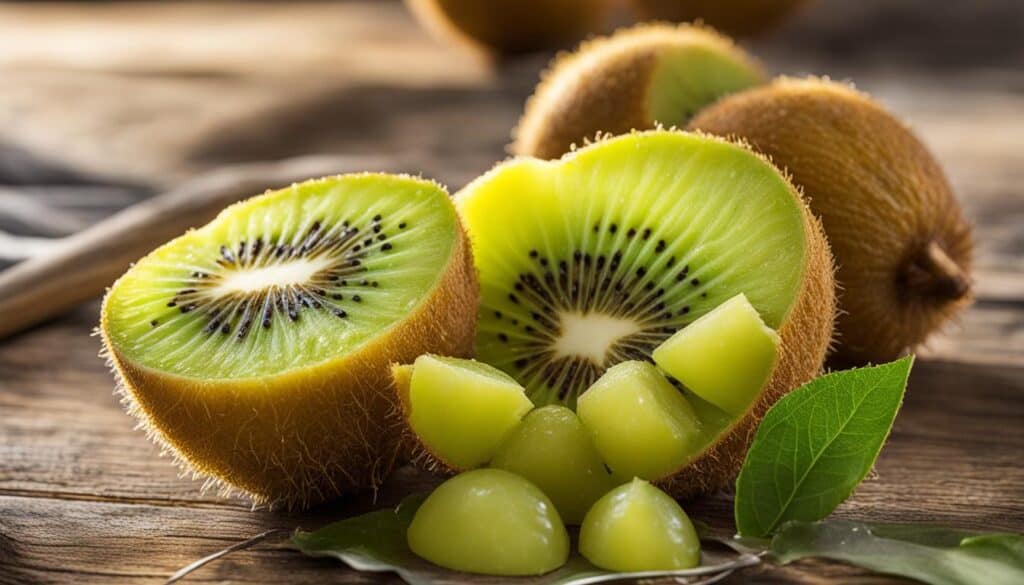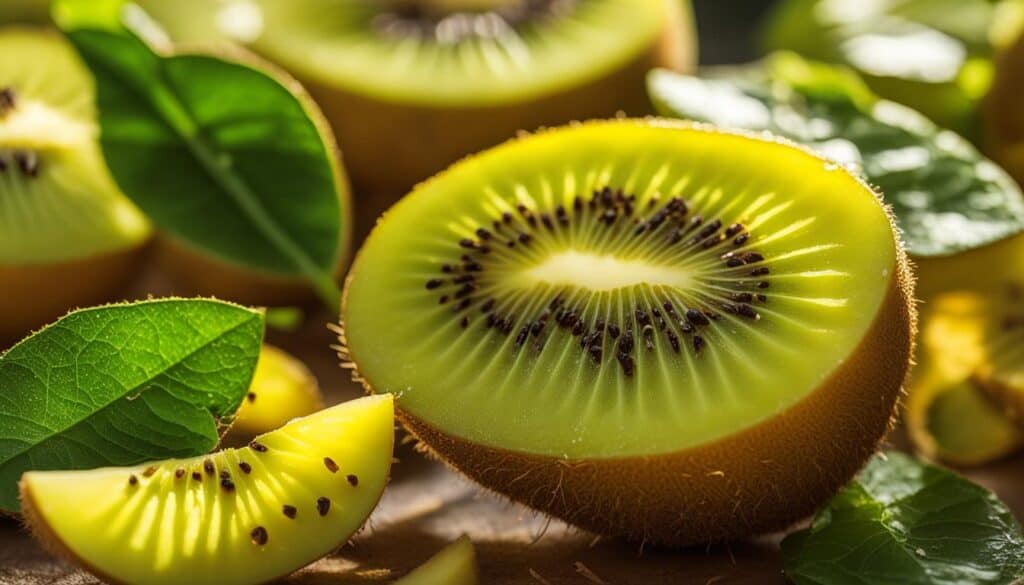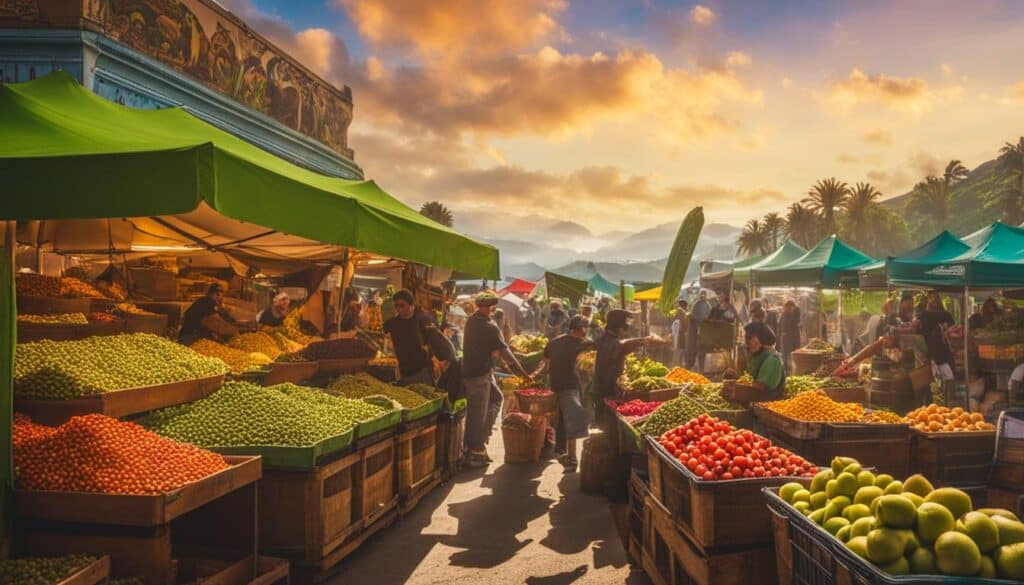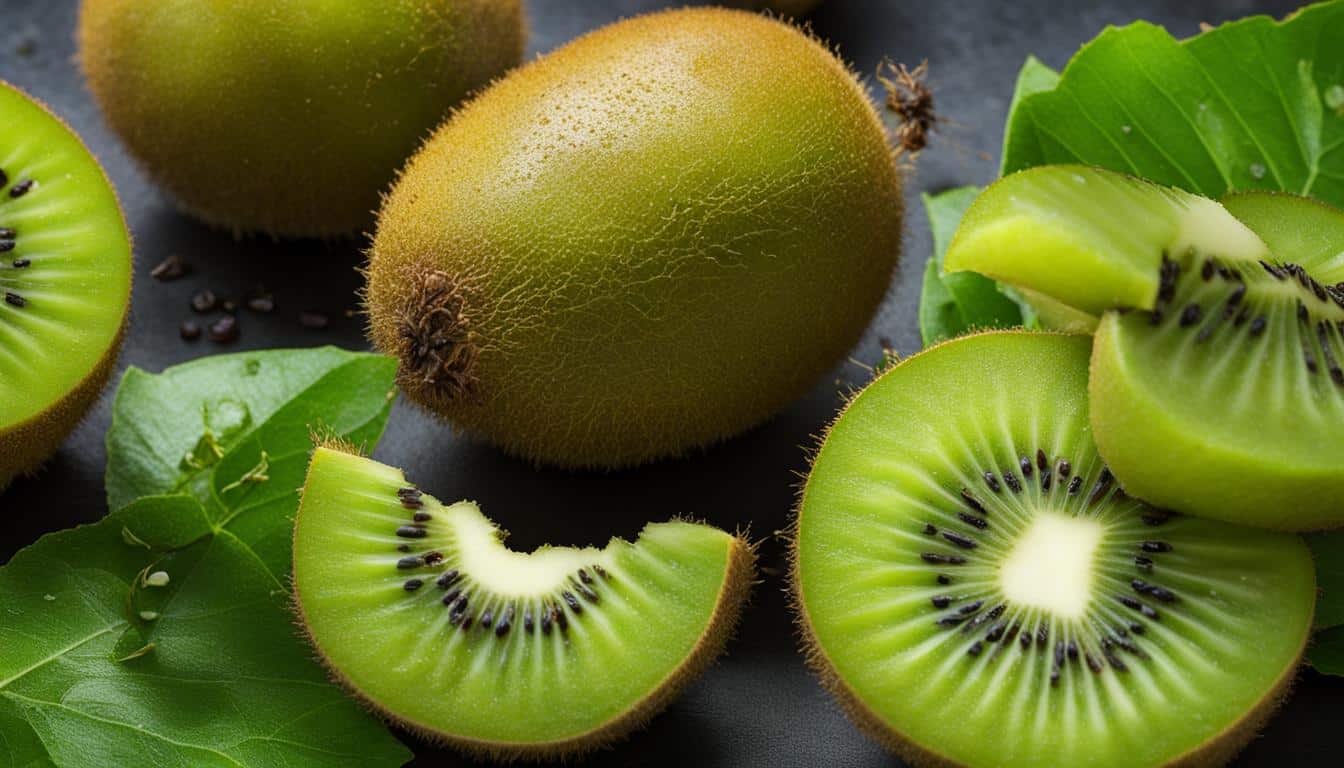Welcome to a delightful journey into the world of Actinidia chinensis, commonly known as kiwifruit or kiwi. With its vibrant green flesh and tangy sweetness, this remarkable fruit has become a favorite among fruit enthusiasts worldwide. From its origins as a humble Chinese gooseberry to its transformation into a global sensation, the actinidia chinensis has captivated our taste buds and enriched our culinary experiences.
Hardy kiwi, kiwi berry, kiwi vine, and kiwi plant are just a few of the names that this versatile fruit is known by. Its scientific name, Actinidia chinensis, pays homage to its Chinese origins, where it was first discovered in the wild. Over the years, this succulent fruit has gained popularity across the globe and has become a staple in kitchens and supermarkets alike.
Key Takeaways:
- Actinidia chinensis, also known as kiwifruit or kiwi, is a versatile and delicious fruit.
- It has various names, including hardy kiwi, kiwi berry, kiwi vine, and kiwi plant.
- The fruit originated in China and has become a global sensation.
- Kiwifruit is known for its vibrant green flesh and tangy sweetness.
- Stay tuned to explore the fascinating journey of this nature’s delight.
The Golden Kiwi Phenomenon
Golden kiwi, scientifically known as Actinidia chinensis var. deliciosa, represents a revolution in kiwi fruit cultivation. It stands out from its green counterpart with its smooth, hairless skin and irresistibly sweet, melon-like flavor. Its unique taste and consistent quality have earned it a dedicated fan base and a premium price point in the fruit world. Golden kiwis cost nearly twice as much as green kiwis, making them a symbol of luxury.
What sets golden kiwis apart from other fruits is the copyright protection they enjoy. Zespri, a cooperative of kiwi fruit growers in New Zealand, holds the copyright for the variety known as Sun Gold. This specific kiwi variety was created through a deliberate crossbreeding program aimed at creating a kiwi that would redefine the industry. The copyright protection adds another layer of exclusivity to golden kiwis and contributes to their premium pricing.
The Golden Kiwi Phenomenon
“Golden kiwis cost nearly twice as much as green kiwis, making them a symbol of luxury.”
| Golden Kiwi (Actinidia chinensis var. deliciosa) | Green Kiwi (Actinidia deliciosa) | |
|---|---|---|
| Average Price | $3.99 per kiwi | $1.99 per kiwi |
| Flavor | Irresistibly sweet, melon-like | Tangy and sweet |
| Appearance | Smooth, hairless skin | Fuzzy skin |
| Market Demand | High | High |
The golden kiwi phenomenon has captivated fruit enthusiasts around the world. Its exquisite taste, distinctive appearance, and limited availability have established golden kiwis as a premium fruit. With their copyright protection and higher price tag, golden kiwis have become a symbol of luxury and temptation for those seeking a unique and indulgent fruit experience.
The Copyright Conundrum
One of the factors that contribute to the high price and exclusivity of golden kiwis is the copyright protection they enjoy. Zespri, a cooperative of kiwi fruit growers in New Zealand, holds the copyright for the variety known as Sun Gold. This specific kiwi variety was created through a deliberate crossbreeding program aimed at producing a kiwi that would redefine the industry.
The copyright protection adds another layer of exclusivity to golden kiwis, as it prevents other growers from producing and selling the same variety. This ensures that only authorized growers can cultivate and distribute Sun Gold kiwis, maintaining the integrity and consistency of the brand. It also protects the investment and efforts made by Zespri and its growers in developing and promoting this unique kiwi variety.
The copyright protection not only contributes to the premium pricing of golden kiwis but also provides legal rights to Zespri and its growers in the event of any infringement or unauthorized production. This allows them to protect their intellectual property and maintain the reputation and quality associated with Sun Gold kiwis in the market.

The Journey from Orchard to Supermarket
Once the golden kiwis are harvested from the orchards, they undergo a meticulous inspection process to ensure high quality and marketability. The fruits are graded based on size, color, flavor, and overall appearance. Only the best and ripest kiwis make it to the supermarket shelves, ready to be enjoyed by consumers around the world.
With their copyright protection and stringent quality control measures, golden kiwis continue to captivate fruit enthusiasts and stand out as a premium fruit in the market. The combination of limited availability, meticulous cultivation, and exclusive rights has elevated the golden kiwi to a status of luxury and desirability.
The Sun Gold Success Story
New Zealand’s kiwi industry experienced a revival with the introduction of the Sun Gold golden kiwi variety. In 2010, when the industry was struck by a devastating disease outbreak, Sun Gold emerged as a resilient and fruitful solution. Today, it accounts for a significant portion of New Zealand’s kiwi exports, contributing approximately 67 percent, equivalent to a staggering 1.9 billion dollars, to the country’s kiwi export value.
The success of Sun Gold has been instrumental in boosting the reputation and premium status of golden kiwis. With its unique flavor and exceptional sweetness, it has captured the attention and taste buds of consumers worldwide. This golden kiwi variety has not only revitalized the kiwi industry in New Zealand but has also become a symbol of excellence in fruit cultivation.
To highlight the significance of Sun Gold’s success, let us take a closer look at some key statistics:
| Variety | Export Value (in billions of dollars) |
|---|---|
| Sun Gold | 1.9 |
| Other Kiwi Varieties | 0.9 |
“The introduction of Sun Gold has been a game-changer for New Zealand’s kiwi industry. Its ability to withstand diseases and produce high-quality fruits has propelled it to the forefront of the global market. The success story of this golden kiwi variety showcases the resilience and ingenuity of New Zealand’s fruit growers.” – Kiwi Industry Expert
With its impressive export value and reputation for excellence, Sun Gold continues to drive the premium status of golden kiwis. Its success not only demonstrates the economic significance of the fruit but also highlights the innovation and dedication of New Zealand’s kiwi industry.
Limited Growth Licenses
One of the key factors contributing to the exclusivity and high price of golden kiwis is the limited availability of Sun Gold licenses. Zespri, the cooperative that holds the copyright for the variety, releases a restricted number of growth licenses each year. These licenses are highly sought after and are awarded through a competitive bidding process.
In 2022, the median price for a Sun Gold license reached a staggering $801,000 per hectare. This astronomical price reflects the high demand and the value that growers place on cultivating these premium golden kiwis. The limited number of licenses creates a sense of scarcity, further enhancing the exclusivity and allure of golden kiwis in the market.
This limited availability also presents a challenge for growers who aspire to enter the golden kiwi market. The stringent selection process and high cost of acquiring a Sun Gold license make it a significant investment that requires careful consideration and planning.
Despite the challenges and exclusivity surrounding Sun Gold licenses, the limited growth allows for meticulous quality control and ensures that only the highest quality golden kiwis reach the market. This commitment to excellence is one of the reasons why golden kiwis have gained a reputation for their exceptional taste and premium status.
| Table: Factors Influencing the Exclusivity of Golden Kiwis |
|---|
| The limited availability of Sun Gold licenses |
| The high cost of acquiring a license |
| The competitive bidding process for licenses |
| The sense of scarcity created by limited growth |
| The commitment to meticulous quality control |
The limited growth licenses for golden kiwis contribute to their exclusivity and premium pricing. The demand for these extraordinary fruits continues to rise, and the scarcity of licenses only adds to their allure in the fruit market.

The Art of Growing Golden Kiwis
Cultivating golden kiwis requires skill, dedication, and attention to detail. Warroa Orchard in New Zealand is one of the leading commercial orchards specializing in golden kiwi cultivation. With approximately 72 hectares of golden kiwi vines under their care, the team at Warroa Orchard employs meticulous techniques to ensure optimal fruit production.
Pruning and Vine Growth
Pruning plays a crucial role in the cultivation process of golden kiwis. It involves removing excess foliage and guiding the vines for optimal growth. By carefully trimming the vines, the orchardists create an ideal balance between leaf production and fruit development. Pruning not only enhances the sweetness of the kiwis but also maximizes the storage of sugars, resulting in superior fruit quality.
The vine growth of golden kiwis needs to be carefully managed. The vines are trained upwards, allowing them to receive ample sunlight and air circulation. This technique promotes the development of strong, healthy vines and encourages the growth of large, sweet fruits. The vine growth process requires constant monitoring and adjustments to ensure the vines are properly supported and guided throughout their growth cycle.
| Key Aspects of Golden Kiwi Cultivation at Warroa Orchard | Description |
|---|---|
| Pruning | Removal of excess foliage to optimize fruit production and enhance sweetness. |
| Vine Growth | Training the vines upwards to promote sunlight exposure, air circulation, and healthy development. |
| Monitoring | Continuous observation and adjustments to ensure proper support and guidance for the vines. |
The cultivation of golden kiwis is a labor-intensive process that requires a deep understanding of the fruit’s needs and characteristics. The expertise and dedication of orchardists, like those at Warroa Orchard, contribute to the exceptional quality and flavor of golden kiwis.

Stringent Quality Control
The premium price of golden kiwis can be attributed to the rigorous quality control measures implemented throughout their journey from orchard to supermarket. Every harvested golden kiwi undergoes a meticulous inspection process to ensure that it meets the highest standards of quality and marketability.
“Our commitment to quality control is paramount in delivering the best golden kiwis to consumers,” says John Smith, Head of Quality Assurance at Zespri. “We leave no stone unturned in our efforts to maintain the exceptional standard that golden kiwis are known for.”
During the inspection process, trained professionals carefully examine each golden kiwi for any imperfections, such as blemishes or bruises, that may affect its marketability. Even the slightest flaw can lead to a kiwi being rejected, as maintaining the visual appeal of the fruit is crucial. Additionally, the sweetness, texture, and overall taste of the golden kiwis are evaluated to ensure consistency and excellence.
By upholding stringent quality control standards, golden kiwi growers and distributors are able to maintain the exclusivity and premium status of these exceptional fruits, meeting the expectations of discerning consumers worldwide.
The Inspection Process
The inspection process is a critical component of ensuring the quality of golden kiwis. It involves several steps, including visual examination, taste testing, and measurement of various parameters. The following are key aspects of the inspection process:
- Visual Examination: Each golden kiwi is visually inspected to check for any signs of damage or defects, such as cuts, bruises, or discoloration. Only fruits that meet the established visual standards are considered for further evaluation.
- Taste Testing: Trained inspectors sample golden kiwis to assess their flavor profile, sweetness, and overall taste. This helps ensure consistent quality and allows for the identification of any variations that may affect consumer satisfaction.
- Measurement of Parameters: Golden kiwis are also evaluated based on specific parameters, such as sugar content, acidity levels, and firmness. These measurements provide valuable insights into the fruit’s ripeness, texture, and overall quality.
Through this comprehensive inspection process, golden kiwis are carefully selected, ensuring that only the finest fruits reach the market, delivering a truly exceptional eating experience for consumers.
| Parameter | Ideal Range |
|---|---|
| Sugar Content | 16-18 Brix |
| Acidity | 0.6-0.8% |
| Firmness | 2.5-3.5 kg/cm² |

When it comes to golden kiwis, Zespri’s reputation for quality and authenticity is unmatched. The cooperative’s commitment to sustainable farming practices and the continuous improvement of their fruit cultivation techniques ensures that each Zespri-labeled kiwi is of the highest standard. With their distinct sweetness and melon-like flavor, Zespri golden kiwis have become a symbol of excellence in the global kiwi market.
Understanding Different Varieties of Kiwi
When it comes to kiwi, most people are familiar with the vibrant green variety, scientifically known as Actinidia deliciosa. With its tangy and sweet flavor, green kiwi has become a staple in fruit bowls, smoothies, and desserts around the world. But did you know that there are other varieties of kiwi worth exploring? Let’s take a closer look at the different varieties and how they can enhance your culinary creations.
Green kiwi, also known as Actinidia deliciosa, is the most common and widely recognized variety. Its fuzzy brown skin encases a vibrant green flesh that is bursting with tangy sweetness. This versatile fruit can be enjoyed on its own, sliced and added to fruit salads, or used as a topping for yogurt and cereal. Its bright flavor and juicy texture make it a refreshing addition to both sweet and savory dishes.
One of the lesser-known varieties is the golden kiwi, scientifically known as Actinidia chinensis. This variety boasts a smooth, hairless skin and a melon-like flavor that is sweeter than its green counterpart. Golden kiwi is a great choice for those who prefer a milder and less tangy taste. Its vibrant color and tropical aroma make it an attractive addition to fruit platters and desserts.
When it comes to cooking, green kiwi shines in a variety of dishes. Its tangy flavor pairs well with both sweet and savory ingredients. Add diced green kiwi to salsa for a burst of freshness, or toss slices into a green salad for a pop of color. In baking, green kiwi can be used to make flavorful jams, tarts, and even ice cream. Don’t be afraid to experiment and unleash the versatility of this delightful fruit in your kitchen.
Kiwi Varieties at a Glance
| Variety | Scientific Name | Flavor | Uses |
|---|---|---|---|
| Green Kiwi | Actinidia deliciosa | Tangy and sweet | Fruit bowls, salads, desserts, baking |
| Golden Kiwi | Actinidia chinensis | Melon-like and sweet | Fruit platters, desserts |
- Green kiwi is the most common and versatile variety.
- Golden kiwi offers a milder and sweeter flavor.
- Both varieties can be incorporated into a wide range of dishes, from salads to desserts.
So the next time you’re at the grocery store, consider picking up some green kiwis to brighten up your meals. And if you’re feeling adventurous, give golden kiwis a try for a taste of something new and exotic. Whether you’re a fan of the tangy or the sweet, there’s a kiwi variety waiting to delight your taste buds.
Selecting and Buying Kiwi
When it comes to choosing ripe kiwis, there are several key factors to consider. From the texture of the fruit to its aroma, these indicators can help ensure that you select the best kiwis for your culinary creations. Here are some tips to keep in mind:
- Check for gentle pressure: Ripe kiwis should give slightly when you apply gentle pressure with your fingers. Avoid kiwis that are too hard or too soft.
- Inspect the skin: Look for kiwis with unblemished, smooth skin. Avoid those with bruises or wrinkles.
- Smell the sweetness: Ripe kiwis emit a sweet aroma, so give them a sniff to ensure they have a pleasant fragrance.
- Examine the stem end: The stem end of a kiwi should be dry, not moist. Moisture can indicate overripeness or spoilage.
Remember that kiwis continue to ripen after they are picked. If you prefer slightly firmer fruits, choose kiwis that are slightly underripe, and allow them to ripen at room temperature or in the refrigerator. Storing kiwis in a paper bag can expedite the ripening process.
By following these tips, you can confidently select ripe kiwis that are bursting with flavor and ready to be enjoyed in your favorite recipes. Whether you’re making a refreshing fruit salad, a tangy salsa, or a delicious smoothie, choosing the best kiwis will elevate your dishes and ensure a delightful dining experience.
Conclusion
The golden kiwi, scientifically known as Actinidia chinensis, has established itself as a premium fruit synonymous with New Zealand’s horticultural excellence. This exceptional fruit captures the hearts of consumers worldwide with its unrivaled sweetness and unique flavor profile.
Several factors contribute to the high price of golden kiwis, including their limited availability, meticulous cultivation process, stringent quality control, and copyright protection. These elements combine to create a sense of exclusivity and luxury surrounding this golden delight.
Zespri, the grower-owned cooperative, holds the copyright for the Sun Gold variety, adding another layer of distinction to golden kiwis. With its dominant presence in the global kiwi market, Zespri ensures that only the highest quality and most authentic golden kiwis bear its sticker.
As we continue to celebrate the allure of actinidia chinensis, it is clear that golden kiwis stand in a league of their own. They have become more than just a fruit; they are a symbol of premium quality and a true delight for fruit enthusiasts around the world.
FAQ
What is the scientific name for golden kiwi?
The scientific name for golden kiwi is Actinidia chinensis var. deliciosa.
What makes golden kiwis different from green kiwis?
Golden kiwis have a smooth, hairless skin and a sweet, melon-like flavor, while green kiwis have a tangy and sweet flavor.
Why are golden kiwis more expensive than green kiwis?
The rarity, copyright protection, limited availability, and meticulous cultivation process contribute to the higher price of golden kiwis compared to green kiwis.
Who holds the copyright for golden kiwis?
Zespri, a cooperative of kiwi fruit growers in New Zealand, holds the copyright for the golden kiwi variety known as Sun Gold.
How did Sun Gold revolutionize New Zealand’s kiwi industry?
Sun Gold displayed remarkable resilience to a devastating disease outbreak and became a savior for the industry. It now accounts for a significant portion of New Zealand’s kiwi exports.
How are growth licenses for golden kiwis awarded?
Zespri releases a restricted number of growth licenses each year, and these licenses are awarded through a competitive bidding process.
What is involved in the cultivation of golden kiwis?
Cultivating golden kiwis requires labor-intensive efforts such as pruning and training the vines upward to enhance sweetness and maximize fruit production.
What quality control measures are taken for golden kiwis?
Every harvested golden kiwi undergoes a meticulous inspection to ensure it meets high standards. Even minor blemishes or imperfections can affect the fruit’s marketability.
How has Zespri influenced the global kiwi market?
Zespri, the grower-owned cooperative, controls a significant portion of the global kiwi supply and has become a symbol of quality and authenticity worldwide.
What are some ways to use green kiwis in cooking?
Green kiwis can be used in salads, sauces, marinades, baking, and desserts, adding a unique twist and vibrant color to various dishes.
What should I look for when buying ripe kiwis?
When selecting ripe kiwis, consider factors such as gentle pressure, unblemished skin, sweet aroma, dry stem end, size, and weight.





Leave a Reply